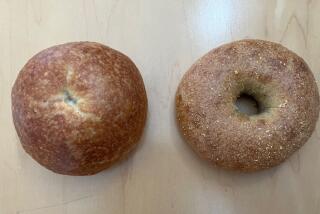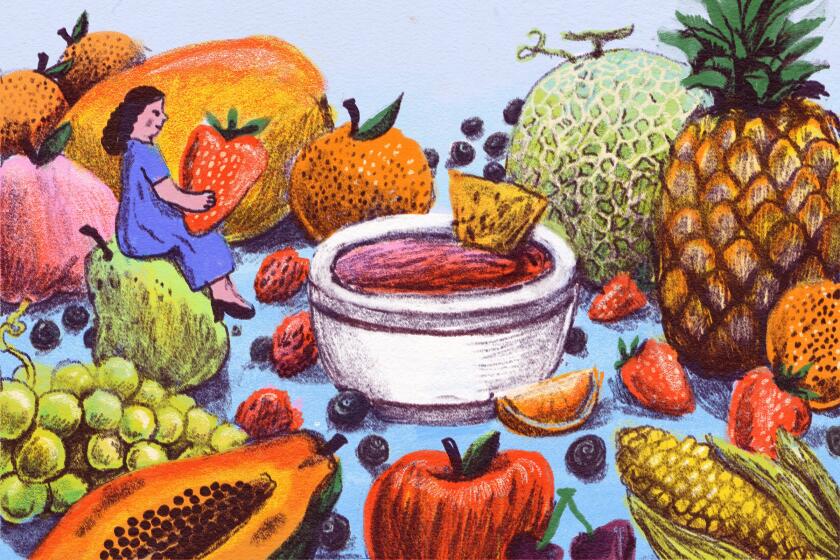Case Law
It’s said that those who love sausages or the law should never watch either being made. I’d argue that the opposite is really true: Those who truly love either should know as much about those processes as possible.
And with sausages, that sometimes means taking casings into your own hands. Making your own sausage is neither as hard nor as messy as it might seem and, though some special equipment comes in quite handy, it’s not too expensive or even necessary if you just want to make sausage patties. In fact, I found making sausage to be much less complicated than I had expected.
In an odd way, that’s due in large part to the shrinking nature of the modern meat market. Although recipes used to be quite specific about the types of pork fat to be used in making different sausages--hard fat, which is higher in saturated fat and, as a result, firmer at room temperature than soft fat, is best for dried or aged sausage; soft fat is best for fresh sausage--today you’ll have to go to some length to find any pork fat at all, aside from cured salt pork.
At first, that seemed to be a major stumbling block. Experts tend to agree that the best sausages contain between 15% and 25% fat. Short of trimming the pork myself, then weighing the respective portions of lean and fat, I was stumped as to how to arrive at that mixture.
It turned out not to be a problem at all. All you really need to know is one cut, two words: pork butt.
That’s the front shoulder of the pig, actually, and by nature, it fits that perfect fat profile, averaging about 20% fat, mostly the softer unsaturated kinds. Better yet, it’s cheap and almost always available.
One fancy market that sold sausage casings didn’t carry pork butt, only the trimmed loin, a far leaner and more expensive part. At around 7% fat, that plainly wouldn’t do. I had to go someplace less expensive to find the more plebeian but correctly fatty cut.
Once your butt is in hand, sausage making is mostly a mechanical process. Grind the meat, season it as you like, stuff it into casings and cook away.
Some special equipment really helps in doing this. You should at least try to find a meat grinder. They’re pretty scarce these days. I had no luck in several so-called gourmet stores but found that in antique and junk stores, hand-cranked models sometimes turn up for around $20.
If you have a food processor, you can use that as a grinder by cutting the meat into half-inch cubes, then pulsing the machine quickly on and off until you have the right texture. Grind in small batches to keep an even consistency and don’t over-process or you’ll wind up with paste.
Failing either of those, some cooks recommend a half-moon shaped rolling chopper, the ones called mezzaluna in Italian and hachoir in French.
If you have a reasonably effective meat grinder, you can come up with quite a range of final textures. Run the meat once through the chopper with the biggest holes and you get something like coarse hamburger. Run it twice through the chopper with the smallest holes and the result is that familiar fine, almost smooth, bratwurst texture.
Those variations affect more than appearance. The more coarsely the meat is ground, the more air pockets are in the sausage. And when the fat melts during the cooking process, those air pockets are where it ends up. That means a coarsely chopped sausage will be juicier than a finely chopped one, in addition to being perceptibly chewier.
The meat will chop better if it is chilled almost to the point of freezing before you run it through the grinder. A second chilling also helps after you’ve seasoned the ground meat. This not only gives the flavors time to mix, it also helps keep the meat from overheating and smearing during the mechanical process of running through the sausage stuffer.
*
If you don’t have a sausage stuffer, any fresh sausage can be served as a patty. A KitchenAid stand mixer has a very slick sausage stuffer that attaches to the meat grinder. These are commonly available at cookware stores in many department stores and from catalogs (see Cookstuff, H9).
Most stuffing machines are pretty basic. The problem is that their instructions are even more so. For a technophobe, it’s not a lot of help to have an instruction sheet that reads: “Carefully stuff sausages,” even if it does say it in six languages. Could we possibly be a little more specific?
Looking through several sausage cookbooks filled in the blanks.
The first thing you have to do is make sure the meat market gives you the right size sausage casings to fit your stuffer. Mine didn’t, and after much wrestling, I discovered that the small casings are just barely big enough to squeeze one end over the large nozzle of my KitchenAid. No matter how much you work, they will go no farther.
The next problem was that the casings kept ripping, even when they were the right size. That was easily solved by liberally greasing the nozzle with shortening. After that, the casings slid right on and off with nary a squeak.
Finally, wait until some stuffing has emerged from the nozzle end before tying off the casing. Tying it off too early ensures that you will end up with a nice big air pocket in your sausage, and that will cause no end of problems down the road.
Casings store very well in the same saline solution they come in. I found the synthetic casings to be a little tougher when cooked but less likely to break when being stuffed. All casings need to be soaked in water at least half an hour before stuffing to remove the preserving salt.
I also find it helpful to rinse the casing before stuffing. Cut the desired length of casing, place it in a large bowl in the sink, attach one end of the casing to the tap and then gently run water through it. The casing will inflate and uncurl, making it easier to use.
*
When you’re stuffing the casings, don’t fill them too full. You’ll need some slack in order to pinch and turn the links. Also, the stuffing will swell during cooking, and if you over-fill them, you’ll get some nasty-looking splits and cracks.
One of the interesting things about making sausages--given the relatively few ingredients and simple techniques--is how much their flavor responds to even small variations. Coarsely ground meat will give a much different sausage than finely ground meat seasoned the same way. Of course, changes in spicing come through loud and clear too.
Though I’m not a fan of some of the more fanciful sausages that seem to be crowding into the market (do we really want sun-dried tomatoes and basil in a sausage?), I did find that given a basic formula, there is a lot of room for experimentation.
After much cooking around, I settled on a mixture of roughly 2 pounds of ground meat (at least half, naturally, pork butt), 2 to 3 teaspoons of salt (depending on your preference and the saltiness of the other ingredients, this can be reduced) and 1/2 cup of cold liquid.
This last is helpful to give the stuffing the right flow to pack easily, but it can also be a signature seasoning. Wine adds a nice depth to the flavor of sausages. Just a 1/2 cup of white wine in the garlic sausages had a profound--and pleasant--effect on the flavor.
Even the size of the casing makes a difference. Flavorful stuffings--like the lamb, orange and rosemary sausage included here--seem to work best with the thin casings. The larger casings seem a little more hearty and are great for juicy things like the white wine and garlic sausage and bratwurst.
And although some cookbooks advise making sausages the day before to let the flavors meld, I found that I preferred the flavor of sausages that have been more recently made. It’s the difference between meat that has been freshly ground and stuff that’s been sitting around for a day.
In sausages as in law, it’s the details that make the difference.
SPICY GARLIC SAUSAGES
This is one of my favorite basic sausages. It’s wonderful by itself or in other dishes.
2 pounds pork butt, coarsely ground
1/2 cup white wine
3 cloves garlic, pressed
1 teaspoon red pepper flakes
3 teaspoons salt
Casings, optional
Combine meat, wine, garlic, pepper flakes and salt and stir well to mix thoroughly. Chill well, at least 1 hour.
Stuff into casings or form into patties. Cook as desired.
8 servings. Each serving:
131 calories; 956 mg sodium; 55 mg cholesterol; 5 grams fat; 1 gram carbohydrates; 17 grams protein; 0.07 gram fiber.
LAMB, ORANGE PEEL AND ROSEMARY SAUSAGES
I prefer this sausage stuffed into narrow casings. It makes a nice presentation if you stuff it in 2- to 3-foot lengths and then form it into a coil. A couple of skewers inserted in a cross will hold the coil together during cooking.
1 pound lamb stew meat, coarsely ground
1 pound pork butt, coarsely ground
1/2 cup red wine
2 teaspoons salt
Grated peel of 1 orange
3 teaspoons minced rosemary
4 cloves garlic, pressed
1 teaspoon red pepper flakes
Casings, optional
Combine lamb, pork, wine, salt, orange peel, rosemary, garlic and red pepper flakes and stir well to mix thoroughly. Chill well, at least 1 hour.
Stuff into casings or form into patties. Cook as desired.
8 servings. Each serving:
131 calories; 654 mg sodium; 55 mg cholesterol; 5 grams fat; 1 gram carbohydrates; 17 grams protein; 0.16 gram fiber.
SMOKERLESS SMOKED BRATWURST
I love smoked bratwurst but, not having a smokehouse, I thought they were impossible. Then I adapted the standard bratwurst recipe from Mimi Sheraton’s “The German Cookbook” (Random House, 1965), using for flavoring a little of the smoked pork loin that is commonly found in supermarkets.
1/4 pound sliced smoked pork loin, finely ground
3/4 pound pork butt, finely ground
1/2 pound veal stew meat, finely ground
Nutmeg
1/4 teaspoon caraway seeds, ground
Pinch marjoram
1 1/2 teaspoons salt
1/2 cup ice water
Casings, optional
Combine smoked pork, pork butt and veal and finely grind second time. Combine meats, grating of nutmeg, caraway, marjoram, salt and ice water and stir well to mix thoroughly. Chill well, at least 1 hour.
Stuff into casings or form into patties. Cook as desired.
6 servings. Each serving:
114 calories; 658 mg sodium; 60 mg cholesterol; 4 grams fat; 0 carbohydrates; 17 grams protein; 0.01 gram fiber.
(BEGIN TEXT OF INFOBOX / INFOGRAPHIC)
CHEIF’S TIPS
Once you’ve made your sausage, how do you cook it? The best way is a two-step process. First, poach the sausage, either in water or in a flavored cooking liquid (wine, beer, stock, etc.) until it is just cooked through and firm, about 20 minutes. Then grill or fry the sausage to brown it nicely.
You can combine these two processes in one pan by poaching the sausage in about 1/2 inch of water in a covered skillet over medium heat. Once it is cooked through, 10 to 15 minutes, remove the lid and increase the heat to high. The liquid will boil away, leaving the sausage to brown in its own rendered juices.
* “Blue Willow” plates, wood background from Hodgson’s, S. Pasadena.
More to Read
Eat your way across L.A.
Get our weekly Tasting Notes newsletter for reviews, news and more.
You may occasionally receive promotional content from the Los Angeles Times.











